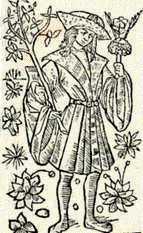John Skelton: Magnificence
There is a play written by the eccentric poet and humanist John Skelton (1460-1529, pictured in the woodcut), called Magnificence. The quality of "magnificence"-- generosity combined with good sense and grandeur-- was ideal for a king.
In Magnificence, the central character, Magnificence, is tempted by political evils, (Crafty Conveyance, Courtly Abusion), and restrained by political virtues (Measure, Perseverance); the plan of the play is similar to The Castle of Perseverance, but its moral is a specifically political one directed at the king (in this case, Henry VIII).
More on how to teach a king
Other plays followed in this tradition, gradually becoming more specific. John Bale's play Kynge Johann (King John), written about 20 years after Magnificence, is a play with a protestant bias; it tells a story from an earlier period in English history, and interprets it as a moral tale. Two actual figures from history--King John and his archbishop, Stephen Langton--appear on stage, but the rest of the characters are morality figures.
Shakespeare's Henry the Fourth, Part One and Part Two have something of the structure of these early political moralities, with Prince Hal as the Magnificence figure, tempted by Falstaff (worldly vanity), Hotspur (ambition), and perhaps Henry IV and John of Lancaster as Machiavels.
